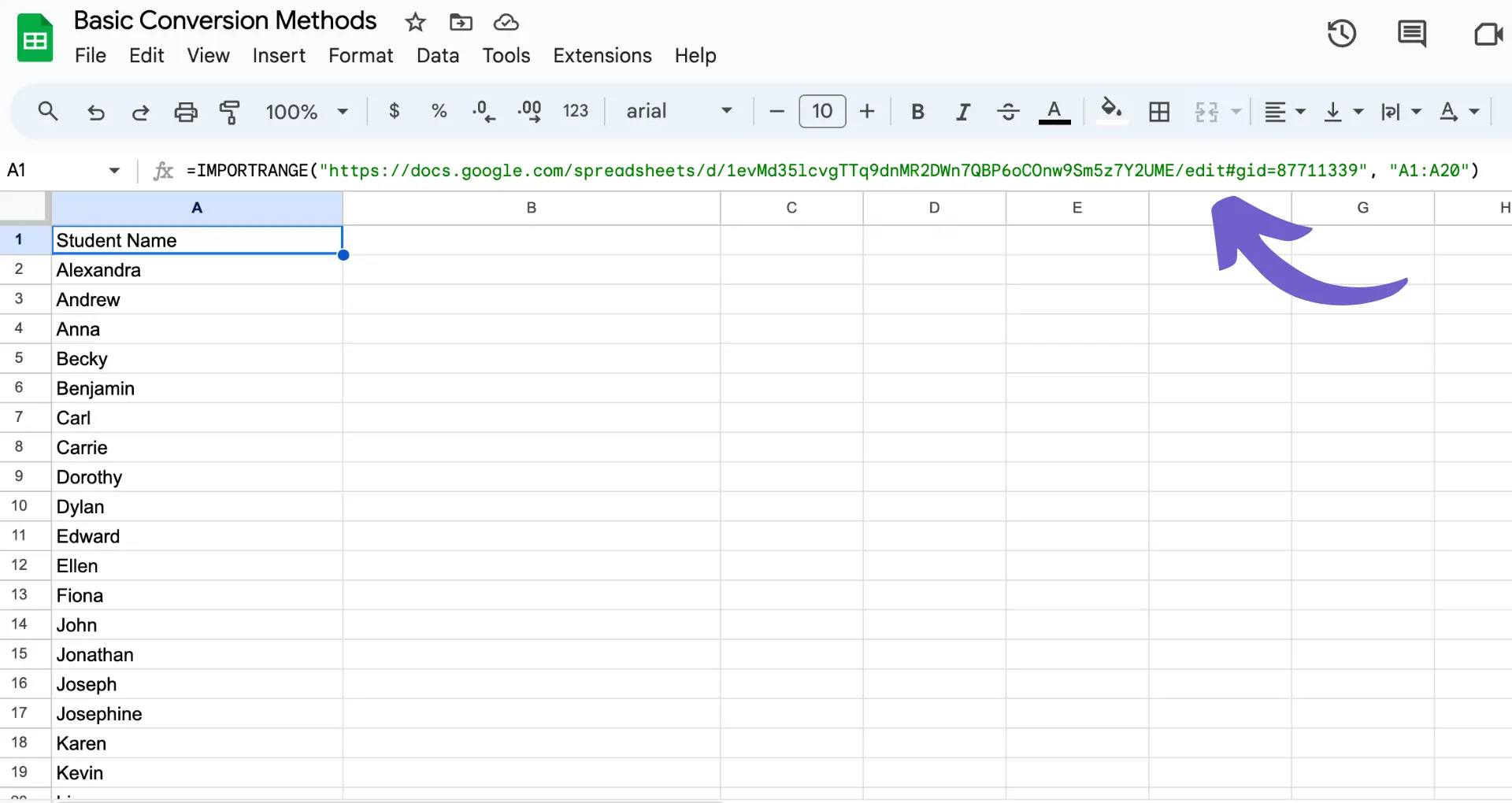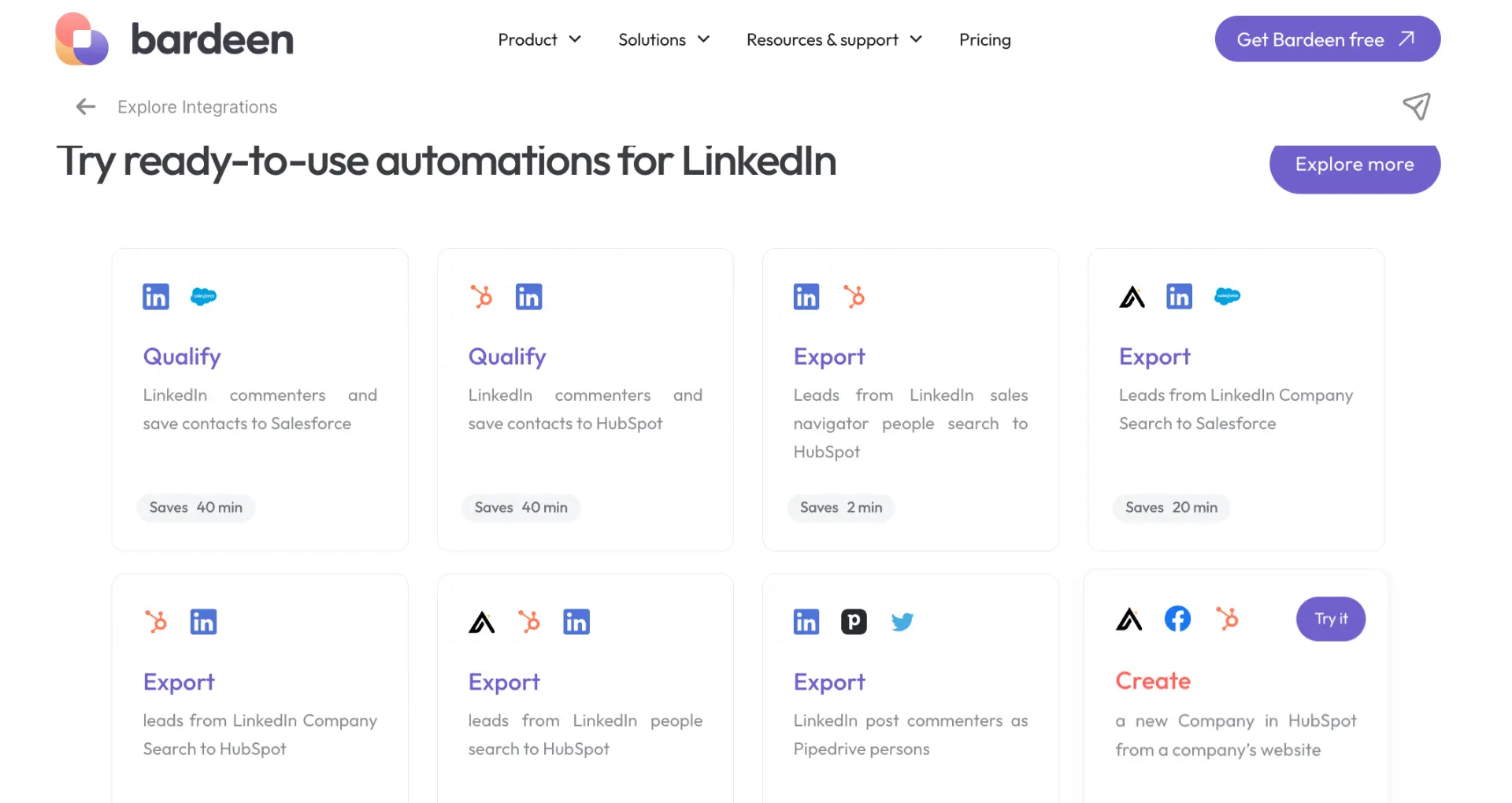





Use IMPORTRANGE to import specific columns in Google Sheets.
By the way, we're Bardeen, we build a free AI Agent for doing repetitive tasks.
If you work with data, try our GPT in Spreadsheets feature. It helps automate data imports and other tasks in Google Sheets.
Importing data from one Google Sheet to another can be a time-consuming task, especially when you only need specific columns. Luckily, Google Sheets provides a powerful function called IMPORTRANGE that allows you to seamlessly bring in data from external spreadsheets. In this step-by-step guide, we'll walk you through how to use IMPORTRANGE to import only the columns you need, saving you time and effort.
IMPORTRANGE is a powerful function in Google Sheets that allows you to import data from one spreadsheet to another. It's particularly useful when you need to connect Google Sheets from multiple sources or share specific data across different sheets. The basic syntax of IMPORTRANGE is as follows:
IMPORTRANGE("spreadsheet_url", "range_string")
To use IMPORTRANGE, simply enter the function in a cell within your destination spreadsheet. For example:
IMPORTRANGE("https://docs.google.com/spreadsheets/d/abc123", "Sheet1!A1:C10")

This will import the data from the specified range in the source spreadsheet into your current sheet. Keep in mind that the first time you use IMPORTRANGE to connect two spreadsheets, you'll need to grant permission by clicking "Allow access" when prompted.
Bardeen can streamline the process of importing data into Google Sheets from various sources. Instead of manually setting up IMPORTRANGE functions, you can use these playbooks to automate importing data from apps like Salesforce, HubSpot, Airtable and more directly into Google Sheets with just a click:
If you're looking to add ChatGPT to Google Sheets, consider using Bardeen's GPT in Spreadsheets action to streamline your workflow.
Before using the IMPORTRANGE function to bring data from one Google Sheets spreadsheet to another, there are a few preliminary steps you need to take:
Once you have the URL of your source spreadsheet, you can use Bardeen to automate enriching that data and copying it to the destination sheet. This can save time compared to manually copying and pasting data between spreadsheets. Try these playbooks:

It's crucial to double-check that the source spreadsheet's sharing permissions are set correctly. If the spreadsheet is not accessible to those who need to use IMPORTRANGE, they will encounter errors when trying to import the data. Ensure that the source spreadsheet is shared with the appropriate individuals or set to "Anyone with the link can view" if you want to make it widely accessible. For more advanced tasks, you might want to enrich LinkedIn profiles using Google Sheets.
If you want to save time, try using Bardeen to connect Google Docs and automate your workflow!
When using IMPORTRANGE to bring data from one Google Sheets spreadsheet to another, you can specify which columns you want to import. This allows you to create customized imports that only include the data you need. To import specific columns, you'll need to use column identifiers in your IMPORTRANGE function.
The basic syntax for IMPORTRANGE with column identifiers is:
=IMPORTRANGE("spreadsheet_url", "sheet_name!column_letter_start:column_letter_end")
For example, if you want to import only columns A, C, and E from a sheet named "Data" in a source spreadsheet, your IMPORTRANGE function would look like this:
=IMPORTRANGE("https://docs.google.com/spreadsheets/d/abc123", "Data!A:A,C:C,E:E")
You can also use column numbers instead of letters. To import columns 1, 3, and 5, you would use:
=IMPORTRANGE("https://docs.google.com/spreadsheets/d/abc123", "Data!1:1,3:3,5:5")
If you want to import a range of columns, you can specify the starting and ending column identifiers. For example, to import columns A through D:
=IMPORTRANGE("https://docs.google.com/spreadsheets/d/abc123", "Data!A:D")
Bardeen can automate the process of importing external data into Google Sheets, saving you time and ensuring your sheets always have the latest data. Try these playbooks:
If you find managing data in Google Sheets useful, you might also like to scrape data from websites directly into your sheets.
By using column identifiers with IMPORTRANGE, you can create customized imports that only bring in the specific data you need, making your spreadsheets more efficient and easier to work with.
You can take your data importing to the next level by combining IMPORTRANGE with the QUERY function. This allows you to filter and refine the data being imported from another spreadsheet, giving you more control over the final result.
The basic syntax for using QUERY with IMPORTRANGE is:
=QUERY(IMPORTRANGE("spreadsheet_url", "data_range"), "query_string")
Here's a step-by-step example of how to structure these combined functions:
For instance, let's say you want to import data from a sheet named "Sales" in another spreadsheet, but only want to include rows where the value in column D is greater than 1000 and the value in column E is "Paid". Your formula would look like this:
=QUERY(IMPORTRANGE("https://docs.google.com/spreadsheets/d/abc123", "Sales!A:E"), "select * where D \u003e 1000 and E = 'Paid'")
Bardeen can take your data importing to the next level by automating the process of getting external data from various sources beyond just spreadsheets directly into Google Sheets, with the data already filtered and formatted to your liking. This can save significant time versus manually importing and manipulating data. Try these playbooks:
By combining QUERY with IMPORTRANGE, you can perform advanced filtering, sorting, and data manipulation on your imported data, making it a powerful tool for working with data across multiple spreadsheets. If you want to scrape data from websites, consider using tools that integrate seamlessly with Google Sheets.
Bardeen can help you double your productivity. Use it to connect Microsoft Excel and automate your workflows without any coding required.
When working with large datasets in Google Sheets, it's essential to optimize your spreadsheet's performance to ensure smooth and efficient data processing. Here are some tips to help you get the most out of IMPORTRANGE and improve overall performance:
Bardeen can help automate data imports and transformations, reducing manual effort and optimizing your sheets for analysis:
When importing large datasets, it's crucial to consider the implications on your spreadsheet's performance. Here are some strategies to manage large imports effectively:
Bardeen can also help with archiving and organizing large volumes of data, such as emails, into Google Sheets for more efficient storage and analysis:
By implementing these best practices and managing your data efficiently, you can optimize the performance of your Google Sheets and ensure that IMPORTRANGE functions run smoothly, even with large datasets. For more advanced techniques, check out data enrichment methods to enhance your workflows.
While IMPORTRANGE is a powerful function for importing data from one Google Sheet to another, users may encounter various issues during the process. Here are some common problems and their solutions:
If you have verified that your IMPORTRANGE function is set up correctly but still encounter issues, try the following troubleshooting steps:
By understanding these common issues and troubleshooting steps, you can ensure a smooth data import process using IMPORTRANGE in Google Sheets.
Bardeen can handle data imports effortlessly, reducing your workload. Try our integration with LinkedIn to automate data extraction efficiently.











SOC 2 Type II, GDPR and CASA Tier 2 and 3 certified — so you can automate with confidence at any scale.
Bardeen is an automation and workflow platform designed to help GTM teams eliminate manual tasks and streamline processes. It connects and integrates with your favorite tools, enabling you to automate repetitive workflows, manage data across systems, and enhance collaboration.
Bardeen acts as a bridge to enhance and automate workflows. It can reduce your reliance on tools focused on data entry and CRM updating, lead generation and outreach, reporting and analytics, and communication and follow-ups.
Bardeen is ideal for GTM teams across various roles including Sales (SDRs, AEs), Customer Success (CSMs), Revenue Operations, Sales Engineering, and Sales Leadership.
Bardeen integrates broadly with CRMs, communication platforms, lead generation tools, project and task management tools, and customer success tools. These integrations connect workflows and ensure data flows smoothly across systems.
Bardeen supports a wide variety of use cases across different teams, such as:
Sales: Automating lead discovery, enrichment and outreach sequences. Tracking account activity and nurturing target accounts.
Customer Success: Preparing for customer meetings, analyzing engagement metrics, and managing renewals.
Revenue Operations: Monitoring lead status, ensuring data accuracy, and generating detailed activity summaries.
Sales Leadership: Creating competitive analysis reports, monitoring pipeline health, and generating daily/weekly team performance summaries.